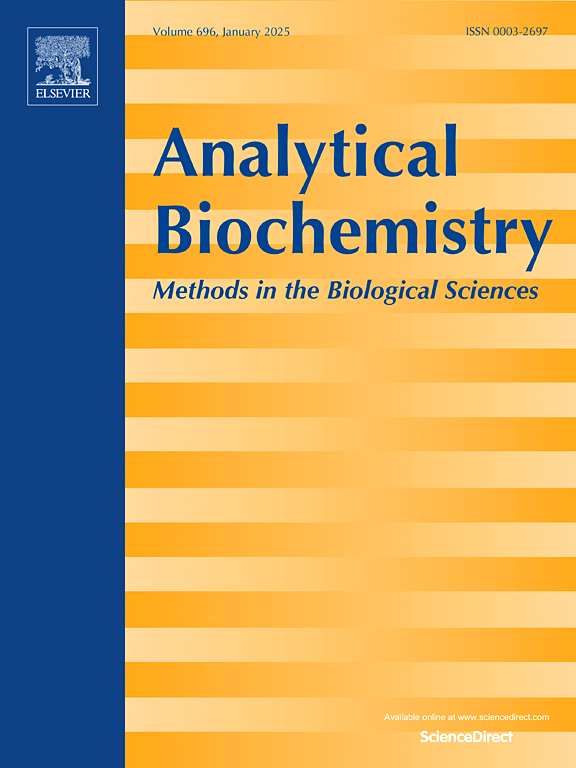Development of an immunochromatographic strip for rapid detection of recombinant rice EPSPS in transgenic crops
IF 2.5
4区 生物学
Q2 BIOCHEMICAL RESEARCH METHODS
引用次数: 0
Abstract
Glyphosate-resistant crops, developed using the EPSPS gene, are widely cultivated globally. Previous studies indicate that the TIPS-OsEPSPS gene provides glyphosate resistance in rice. In this research, the OsmEPSPS gene was utilized to develop glyphosate-resistant, maize, and soybean, and a rapid immunochromatographic strip (ICS) test was designed for specific detection of the OsmEPSPS protein. The ICS test employs a double-antibody sandwich format with two monoclonal antibodies: mAb #9, conjugated to colloidal gold for capture, and mAb #15, for detection at the test line. The ICS exhibited a limit of detection (LOD) of 0.031 μg/mL within 10 min. Additionally, the ICS could detect a concentration of 0.817 μg/mL within 1 min in both Eleusine indica and OsmEPSPS-overexpressing plants. The ICS is highly specific, sensitive, and stable, with an R2 value of 0.982. Notably, the ICS is capable of detecting EPSPS proteins with high homology to OsmEPSPS from Poaceae and other plants. In summary, this study developed a sensitive and specific test strip for OsmEPSPS detection, facilitating semiquantitative analysis on the basis of colorimetric response time and intensity. This ICS is not only suitable for the rapid identification of OsmEPSPS-overexpressing plants but also for phylogenetic analysis of EPSPS gene homology.

快速检测转基因作物中重组水稻EPSPS免疫层析条带的建立。
利用EPSPS基因开发的抗草甘膦作物在全球广泛种植。先前的研究表明,TIPS-OsEPSPS基因提供了水稻对草甘膦的抗性。本研究利用OsmEPSPS基因培育抗草甘膦玉米和大豆,并设计了快速免疫层析条带(ICS)检测OsmEPSPS蛋白的方法。ICS测试采用双抗体夹心格式,包含两种单克隆抗体:mAb #9与胶体金结合用于捕获,mAb #15用于在测试线上检测。该方法在10 min内检测限为0.031 μg/mL,在1 min内检测浓度为0.817 μg/mL。该方法特异性强、灵敏度高、稳定性好,R2值为0.982。值得注意的是,ICS能够检测到与禾科和其他植物中OsmEPSPS具有高度同源性的EPSPS蛋白。综上所述,本研究开发了一种灵敏、特异的OsmEPSPS检测试纸条,可基于比色响应时间和强度进行半定量分析。该系统不仅适用于过表达植物的快速鉴定,也适用于EPSPS基因同源性的系统发育分析。
本文章由计算机程序翻译,如有差异,请以英文原文为准。
求助全文
约1分钟内获得全文
求助全文
来源期刊

Analytical biochemistry
生物-分析化学
CiteScore
5.70
自引率
0.00%
发文量
283
审稿时长
44 days
期刊介绍:
The journal''s title Analytical Biochemistry: Methods in the Biological Sciences declares its broad scope: methods for the basic biological sciences that include biochemistry, molecular genetics, cell biology, proteomics, immunology, bioinformatics and wherever the frontiers of research take the field.
The emphasis is on methods from the strictly analytical to the more preparative that would include novel approaches to protein purification as well as improvements in cell and organ culture. The actual techniques are equally inclusive ranging from aptamers to zymology.
The journal has been particularly active in:
-Analytical techniques for biological molecules-
Aptamer selection and utilization-
Biosensors-
Chromatography-
Cloning, sequencing and mutagenesis-
Electrochemical methods-
Electrophoresis-
Enzyme characterization methods-
Immunological approaches-
Mass spectrometry of proteins and nucleic acids-
Metabolomics-
Nano level techniques-
Optical spectroscopy in all its forms.
The journal is reluctant to include most drug and strictly clinical studies as there are more suitable publication platforms for these types of papers.
 求助内容:
求助内容: 应助结果提醒方式:
应助结果提醒方式:


